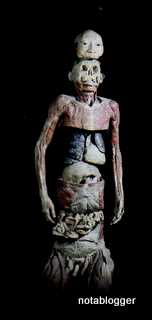I don't know who is more mad, me for wanting to see this exhibit or the creator of this exhibit, Dr Gunther von Hagens.
 |
| Neobabylon Bldg |
Located in 2 beautiful buildings connected by a bridgeway along Bayani Road in Taguig, the Myth of the Human Body Exhibit, which will run until April 17 aims to educate people on the human body.
The exhibit is divided into 7 parts.
 |
| Heracles |
Heracles, better known as Hercules in Roman mythology, son of Zeus, a divine hero, appropriately represents the muscular and skeletal system.
 |
| Poseidon |
Poseidon, Greek god of the sea, represents the respiratory system exhibit where you will be able to see the difference between the lungs of urban dwellers versus those living in the country, away from pollutions.
 |
| Dionysus |
Dionysus, Greek god of wine harvest, also known as Bacchus to the Romans represents the digestive system.
 |
| Hades |
Hades, older brother of Zeus and Poseidon, ruler of the underworld represents the circulatory system. Here you can see the Red Man, plasticized coral looking arteries that was reshaped into a man.
 |
| Eros |
Eros, the fertility deity and god of sexual love and beauty represents the reproductive system. This part of the exhibit features cut off parts of the male and female sexual organs and also a short film about what happens inside a female body from conception to birth. I think this short clip has made my guy friend rethink his wish to have more kids. Especially when it showed what pregnancy does to woman's body inside.
 |
| Zeus |
Zeus, youngest brother of Hades and Poseidon, is the god of gods and men. He represents the brain and nervous system.
 |
| Artemis |
Artemis, known as the greek goddess of the hunt, is also Eileithyia, Cretan goddess of childbirth and midwifery. This part of the exhibit was what disturbed me the most since it showed a 1 day old fetus up to a 10 month old preterm baby, a plasticized baby that was cut in half, lengthwise and a woman cut open with a baby in her womb.
 |
| Plastination Technique |
Plastination is a technique used in anatomy to preserve bodies and parts by first injecting formalin into the body to stop the decaying process, and then replacing the body fluids and fats with acetone and then injecting a polymer solution into the body, yielding specimens that are preserved, can be touched, with very little smell and can last for decades.
Walking through the exhibit, I had to remind myself that these were actual living breathing human beings at one time. It was really hard not to objectify them. It was equally hard for me to picture someone allowing this to happen to them or a family member donating their loved one's body for this. Though the exhibitors claim that these were donated bodies, I can't help but wonder if it was 100% true given that all the bodies were from China, a country not really known for upholding human rights.
Truth be told, morbid curiosity drew me to this exhibit, knowing all the controversy surrounding it. And though the guides were trying to focus on the educational aspect of the exhibit, very scripted as it was, I wonder where do you draw the line between education, questionable art and ghoulish entertainment.
Myth of the Human Body
Neobabylon Building, 9 Bayani Road, AFPOVAI, Taguig City
889-5467 or 889-1724
Entrance Fee: Php350/person
note: all photos above, except for the Neobabylon Bldg, were taken from the exhibit's brochure.
update: I saw this, of what at first I thought was a mannequin or a replica, but is actually part of the exhibit, called Skin Man, displayed in a shop in GB5 for promotional purpose. Tasteful promotion or insensitive tactlessness...you decide.....












This comment has been removed by a blog administrator.
ReplyDelete